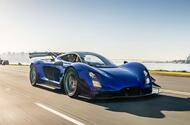Why Did Czinger Decide to Focus Solely on the 21C Hypercar?
If you’ve been following the world of high-performance cars, you’ve probably heard Czinger’s name tossed around—usually in the same breath as words like “revolutionary” and “3D-printed.” But recently, the California-based company made a bold move: it’s shelving plans for a grand tourer and an SUV to double down on its flagship, the 21C hypercar. Why the pivot?
According to George Biggs, Czinger’s new Chief Commercial Officer, the answer is simple but strategic. Czinger wants to be more than just another luxury carmaker chasing trends. Instead, the brand is aiming for a sweet spot: ultra-high-end performance with a real commitment to sustainability. Biggs points out that brands with a clear, unwavering vision tend to outlast those that jump on every market bandwagon. For Czinger, that means resisting the temptation to follow the current SUV craze and instead building on what makes the 21C special.
What Makes the Czinger 21C Stand Out in a Crowded Hypercar Market?
Let’s be honest—there’s no shortage of jaw-dropping hypercars these days. So what puts the 21C in a league of its own? For starters, it’s not just the 1,233 horsepower or the hybrid twin-turbocharged 2.88-liter V8 under the hood (though those numbers are nothing to sneeze at). It’s the way Czinger builds the car that really turns heads.
Czinger uses advanced 3D printing for major structural components, a technique that’s still rare in automotive manufacturing. This approach allows for lighter, stronger parts and lets engineers push the boundaries of what’s possible in design and performance. The result? A car that’s not just fast, but also incredibly innovative—both in how it’s made and how it drives.
And then there’s the seating. The 21C’s tandem arrangement (think fighter jet, not family sedan) isn’t just for show. It reduces the car’s frontal area, cutting drag and boosting performance. It’s a small detail, but it speaks volumes about Czinger’s willingness to rethink the basics in pursuit of something extraordinary.
How Is Czinger Planning to Keep the 21C Relevant Through 2035 and Beyond?
Here’s where things get really interesting. Instead of rolling out a new model every few years, Czinger is planning to evolve the 21C with fresh variants and updates well into the next decade. This isn’t just about new paint jobs or minor tweaks. Biggs hints at the possibility of versions with more traditional seating or even more extreme performance, building on the track-focused 21C V-Max.
This approach mirrors what we’ve seen from some of the world’s most respected luxury brands: keep the core product strong, but adapt it to meet the changing desires of a passionate customer base. It’s a strategy that not only keeps the car in the spotlight but also allows Czinger to apply its cutting-edge technology in new and unexpected ways.
What Role Does Sustainability Play in Czinger’s Future?
Sustainability isn’t just a buzzword for Czinger—it’s baked into the company’s DNA. The use of 3D printing isn’t just about performance; it’s also about reducing waste and improving efficiency. By manufacturing only what’s needed, Czinger minimizes excess material and energy use, which is a big step forward in an industry often criticized for its environmental impact.
Biggs makes it clear that Czinger’s vision for the future is as much about responsibility as it is about speed. The company is betting that the next generation of hypercar buyers will care just as much about how their cars are made as how fast they go. And with global regulations tightening and consumer expectations shifting, this focus on sustainability could be what keeps Czinger ahead of the curve.
Will We Ever See a Czinger SUV or GT in the Future?
Never say never, but for now, Czinger’s leadership is adamant: the focus is on the 21C and its variants. That said, the company isn’t ruling out broader applications of its technology down the line. Biggs describes a culture of innovation, where engineers are encouraged to dream big and push boundaries. If the market—and Czinger’s customers—signal a real appetite for something new, the company has the tools and the talent to deliver.
But for now, Czinger is playing the long game. Rather than diluting its brand with too many models, it’s investing in what it does best: building one of the most advanced, exciting hypercars on the planet.
What Can Enthusiasts Expect Next from Czinger?
If you’re a fan of bleeding-edge automotive technology, Czinger’s next moves are worth watching. Production of the 21C V-Max, the even more track-focused sibling of the standard 21C, is set to begin soon. Only 88 units of the standard 21C will be produced, making each one a rare collector’s item.
Looking further ahead, expect Czinger to roll out new variants that push the envelope even further—whether that means different seating configurations, wild new performance benchmarks, or unexpected uses of its pioneering 3D-printing technology.
The Takeaway: Why Czinger’s Approach Matters
Czinger’s decision to focus on the 21C isn’t just about building a faster car—it’s about redefining what a hypercar company can be. By marrying high performance with sustainability and a relentless drive for innovation, Czinger is carving out a unique space in the automotive world. It’s a reminder that sometimes, the smartest move isn’t to chase every trend, but to double down on what you do best—and do it better than anyone else.
For car enthusiasts and industry watchers alike, Czinger’s journey is one to keep an eye on. The outcome? Potentially game-changing. And in a world where the next big thing is always just around the corner, that’s saying something.

